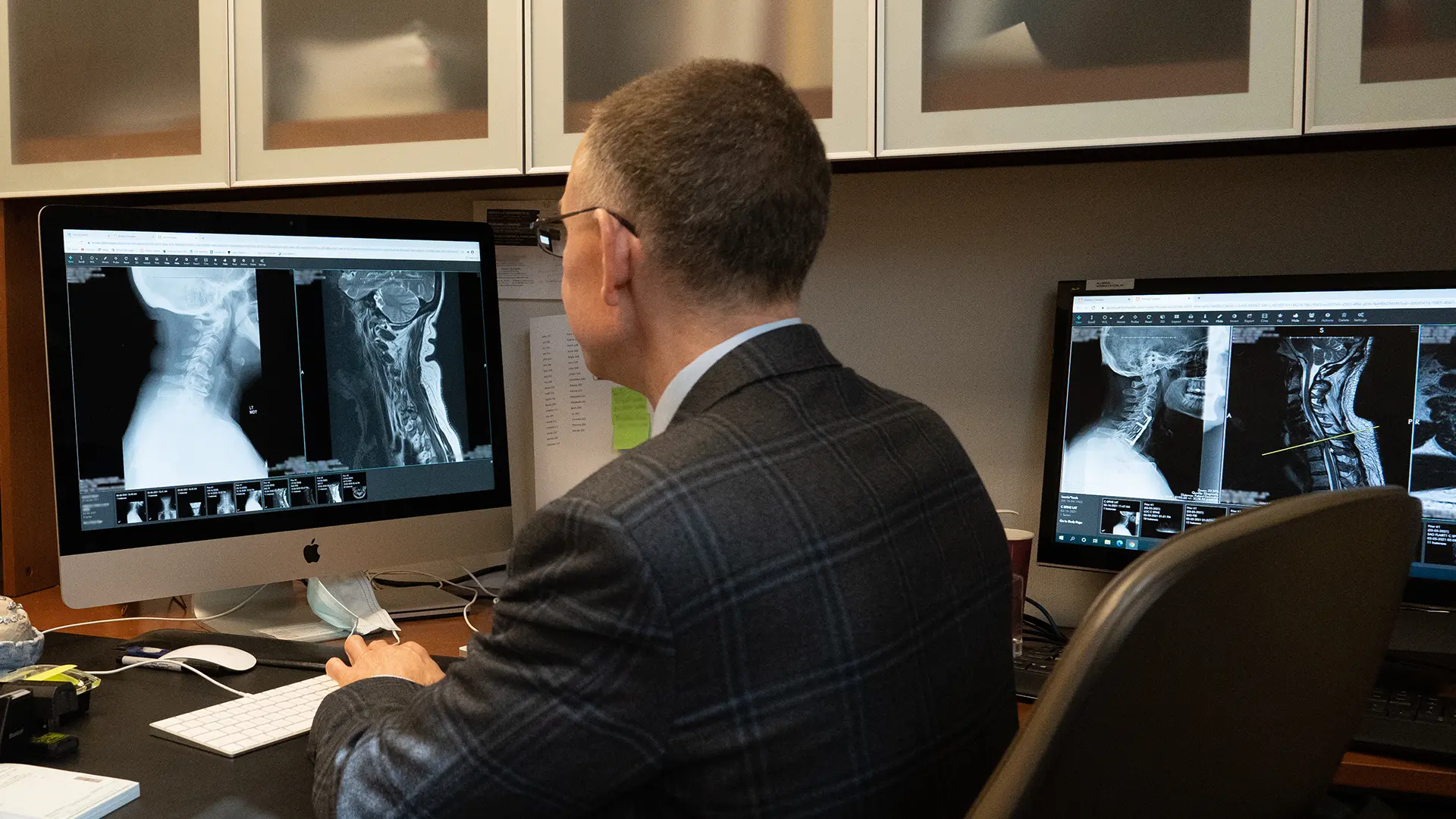Filter By Location
Show All Locations
Eatontown
Edison
Glen Ridge
Holmdel
Livingston
Morristown
Nyack
Paterson
Ridgewood
Toms River
Wayne
Cervical spine treatments are used to address conditions affecting the neck and upper spine, helping patients regain mobility and get back to their lives.
Our specialized approach to cervical spine care focuses on advanced techniques that promote faster healing and better outcomes for our patients.
When spinal stability is compromised, fusion procedures can provide the structural support needed to eliminate pain and restore function.
For patients seeking to maintain neck mobility, artificial disc replacement provides an alternative to fusion, preserving natural spine movement.
Our board-certified surgeons are experienced in treating complex cervical spine conditions. They are trained in both traditional and minimally invasive surgical techniques and provide personalized care tailored to your specific needs.
At Neurosurgeons of New Jersey, we’re one of the few neurosurgical practices in the state that accepts all major insurance plans. Partnered with a vast network of in-network insurance providers, we work with you to get the care you deserve, making high-quality cervical spine care more accessible. Our insurance specialists can check your coverage and help navigate the approval process with you.




James is a retired police officer. He loves being active and spending time with family. One day while playing catch with his grandson everything changed…
Watch James share his experience of getting back to normal after being treated by Dr. Appelboom.
Jerry is a retired college professor who loves to stay active. After starting to experience numbness in his fingers and loss of balance, he contacted the Neurosurgeons of New Jersey Eatontown office and met Dr. Lustgarten.
Watch Jerry share his experience of how Dr. Lustgarten saved the day!
Helena is a mother of five who loves to garden. One day while gardening, she began to experience tingling in her hand, and eventually shooting pain through her arm and shoulder. Eventually, Helena was diagnosed with cervical stenosis. Her journey led her to Dr. Michael G. Kaiser at the Neurosurgeons of New Jersey, who helped her get back to the garden!
Watch Helena share how Dr. Kaiser returned her to the life she loved!
1200 East Ridgewood Ave, Suite 200 & 209
Ridgewood, NJ 07450
201-327-8600
St. Barnabas ACC
200 South Orange Avenue, Suite 265
Livingston, NJ 07039
973-577-2888
745 Hope Road,
Eatontown, NJ 07724
732-222-8866
530 Lakehurst Road
Toms River, NJ 08755
732-222-8866
703 Main Street, Suite A2404
Paterson, NJ 07503
973-782-9175
311 Bay Avenue, Suite 201
Glen Ridge, NJ 07028
973-577-2883
3840 Park Ave, Suite 103B
Edison, NJ 08820
732-372-7085
1680 Route 23 North, Suite 300
Wayne, NJ 07470
973-782-6073
10 Waldron Avenue
Nyack, NY 10960
845-535-1655
Bell Wellness
101 Crawfords Corner Road, Holmdel, NJ 07733
732-222-8866




Need more information? Contact us at 551-284-3265 to schedule a consultation with one of our cervical spine specialists.
Yes, cervical spine surgery is considered major surgery, but it’s also one of the safest and most effective treatments for serious neck and nerve problems. Here’s what “major surgery” means for cervical spine procedures:
Why it’s classified as major surgery:
Safety and success rates:
Recovery timeline for major cervical spine surgery:
The “major surgery” classification reflects the procedure’s complexity and importance, not necessarily length or danger. Modern minimally invasive techniques have made cervical spine surgery safer and more effective than ever.
Cervical spine surgery recovery time varies by procedure type, but most patients see significant improvement within 2-6 weeks. Here’s a detailed recovery timeline:
Immediate recovery (0-2 weeks):
Early recovery (2-6 weeks):
Complete recovery (6-12 weeks):
Factors affecting cervical spine surgery recovery:
Minimally invasive cervical spine surgery typically offers faster recovery times compared to traditional open procedures.
Good candidates for minimally invasive cervical spine surgery typically have specific conditions and characteristics that make them suitable for these advanced techniques:
Ideal conditions for minimally invasive approaches:
Patient characteristics for minimally invasive surgery:
Benefits of minimally invasive cervical spine surgery:
Conditions requiring traditional open surgery:
Minimally invasive cervical spine techniques available:
Evaluation process: During your consultation, our spine specialists review your MRI, CT scans, and symptoms to determine if minimally invasive techniques can address your specific condition effectively.
Success rates for minimally invasive cervical surgery:
Not everyone qualifies for minimally invasive approaches, but when appropriate, these techniques offer significant advantages over traditional surgery.
Most patients can return to work within 2-3 weeks and drive within 2-3 weeks after cervical spine surgery, though exact timing depends on several factors:
Return to driving after cervical spine surgery:
Return to work timeline:
Factors affecting return to work:
Gradual return strategies:
When to delay return:
Your spine surgeon will provide specific return-to-work guidelines based on your procedure and recovery progress.
Yes, most patients benefit from physical therapy after cervical spine surgery, though the timing and intensity depend on your specific procedure and recovery progress.
Why physical therapy is important:
Physical therapy timeline:
Types of cervical spine physical therapy:
Physical therapy duration:
Conditions requiring specialized PT:
PT outcomes:
Your spine surgeon and physical therapist work together to customize your rehabilitation program based on your specific procedure and goals.
ACDF (Anterior Cervical Discectomy and Fusion) and cervical disc replacement are two surgical approaches for treating cervical spine problems, each with distinct advantages:
ACDF Surgery:
Cervical Disc Replacement (Artificial Disc):
Key decision factors:
Which procedure is right for you? This depends on your specific condition, imaging results, age, and lifestyle goals. During consultation, our spine specialists evaluate these factors to recommend the optimal approach.
Cervical spine surgery complication rates are low, but understanding potential risks helps you make an informed decision about treatment:
Common, minor complications (1-5% occurrence):
Uncommon complications (less than 1% occurrence):
Rare, serious complications (less than 0.5% occurrence):
Cervical spine surgery safety statistics:
Risk factors that increase complications:
How to minimize your risk:
When performed by experienced spine specialists, cervical spine surgery has excellent safety profiles with minimal risk of serious complications.
Most patients retain 85-90% of normal neck movement after cervical fusion surgery, with the majority experiencing no significant limitations in daily activities.
How cervical fusion affects neck movement:
Real-world neck movement after fusion:
Factors affecting post-fusion neck mobility:
Timeline for neck movement recovery:
Patient satisfaction with neck movement:
Alternative for motion preservation:
Maximizing neck mobility after fusion:
The key is that while some neck movement may be reduced, the elimination of pain typically far outweighs any mobility limitations.
Effective pain management after cervical spine surgery involves a multi-modal approach designed to keep you comfortable while promoting healing:
Immediate post-operative pain management (0-48 hours):
Pain management at home (first 1-2 weeks):
Transitional pain management (weeks 2-6):
Expected pain levels after cervical spine surgery:
Pain management best practices:
When to contact your surgeon about pain:
Non-medication pain relief strategies:
Most patients find their post-surgical pain is much more manageable than the chronic pain they experienced before surgery, and pain relief continues to improve over the first few months.
Cervical spine surgery becomes necessary when conservative treatments fail to provide adequate relief and specific medical criteria are met. Here’s how we determine the right approach:
Try conservative treatment first for:
Conservative cervical spine treatments include:
Surgery becomes necessary when:
Emergency situations requiring immediate surgery:
Red flag symptoms indicating urgent evaluation:
Factors favoring surgical intervention:
Factors favoring continued conservative care:
Shared decision-making process:
Success predictors for cervical spine surgery:
Our approach to treatment decisions: We believe in exhausting appropriate conservative treatments before recommending surgery, unless emergency situations exist. The goal is always to achieve the best possible outcome with the least invasive approach that meets your functional needs and lifestyle goals.
Surgery should significantly improve your quality of life and ability to enjoy activities that matter to you. If conservative treatment can achieve these goals, we support that approach. When surgery offers the best chance for relief and return to full function, we’ll recommend that path with complete transparency about what to expect.